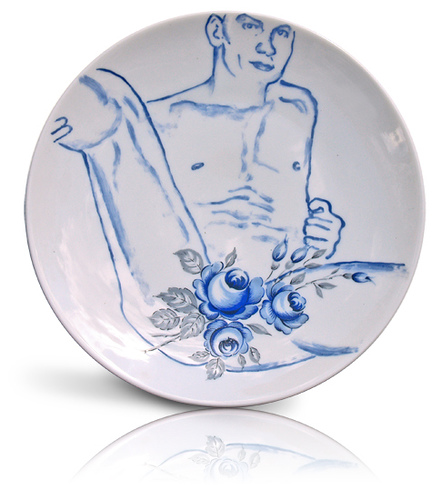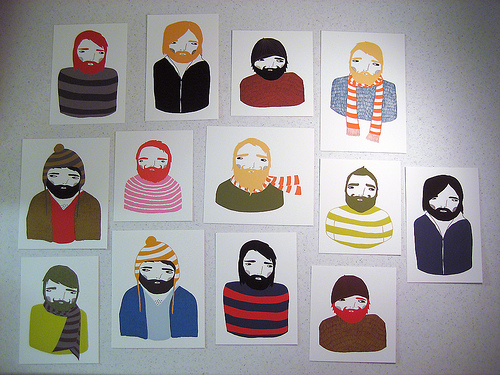A humidifier, apparently.
Author: sarah
Bunnies, rabbit ears, overwhelming subtext.
Art, deer, non-modified just retro.
A desktop image about attachment.
More modified art, counterfeit Jesus, web zen.
This sounds like fado, and I want to add halos to every bearded image.
Look good naked, bring your own analysis, a lot of video links.
A bloggy friend of Erin’s posted about a TV show called How To Look Good Naked. I don’t have cable, and I didn’t know anything about this show. This blogger, Sarah, said the show basically relied on body image coaching to help women like their nude bodies, with no weight loss or surgery suggestions at all. I found this improbably thrilling news regarding a reality makeover show, so I looked it up on YouTube. This is from the American version (the original is British).
They just pointed out that plastic surgery doesn’t work? On TV? And they used their feelings to decide how to solve their personal distress? Yay hooray! The clips I found raise a ton problems for me, but wow, I am really happy to see this conversation happening on a mainstream makeover show.
Problems/boring parts:
- That blond mom clearly spends a lot of time grooming and performing “being pretty.”
- The show stars a man as the expert despite being about women’s body image.
- It’s safe to have this man see you in your underwear because he’s gay, but I don’t see anyone pointing out how that makes straight men’s expected behaviour quite obviously problematic. (Also in that clip, host Carsen casually equates strippers and low-class names, managing to bash both at once. There are other ways to make that joke, sir.)
- It focusses on a lot of external validation (mirrors, man host’s perspective, other people’s compliments).
- The show values looking conventionally femme and ‘sexy’ over feeling comfortable (external validation again).
- They have a half-assed acceptance of fat (don’t hide your fat… because that will make you look fatter).
- It demonstrates the conventionally feminine ambigious ‘no’ (giggle giggle smile) and seems to believe that coerced nudity is ok if one person really thinks it’s for the best.
- Obviously the producers just realized that “real beauty” will attract a valuable target demographic (thanks for that, Dove).
- Based only on these clips, they don’t seem to point out that your body has any endearing qualities besides the way it looks.
- The host looks like he’s had some work done himself.
And yet, I am still definitely pleased to see a rounded woman’s butt cellulite on screen in a positive context, hear someone make the basic point that clothes need to fit your body and not vice versa, and even see men touching each other fairly comfortably.
This is a very narrow discussion of body image, but it is at least in a direction that I value: unpacking all the crap that people said you should do and deciding for yourself. (My body and I are totally bff almost all the time anyway, so I’m not disappointed about the lack of new ground.)
It’s quite the comment on the state of TV that eliminating weight loss and surgery without discussing anything else is cause for celebration, but maybe these baby steps will make some room for a similar show that adds a couple of elements, and then a couple more. No weight loss, no surgery, and no dissing fat. Or getting to know your body without looking at it. Queer eye for the straight girl, finally, or a show where women come up with ways to enjoy their bodies without a host/star/authority at all. I dream.
Alien menstruation, casual toilet time.
I notice I am posting things here that ordinarily I would post at All About My Vagina, because I am not happy with the design over there.
Art hacks, silhouettes, checkers death match.
Monsters on thrift store art.
Thinking about enhancing thrifted plates reminded me of the vintage vandals shows from 2005.
Blue Rose, campy modified plate set
About a thousand dollars for the set of six. More importantly, this gives me all kinds of ideas for things to do with thrift store plates.
Beards & stripes
Apparently these will be for sale on Etsy. I’m filing this under “knitting” because the stripes are giving me a yarn urge.
Ernst Haeckel, categorization, sets of sets, primary colours, dog tv
I fell into a bit of a well of naturalism and anatomy links, and ended up wanting to read Stuffed Animals and Pickled Heads: The Culture and Evolution of Natural History Museums, although I’m pretty sure it isn’t as critical or curious as I want it to be. One review quotes this tedious oversimplification as a “philosophical insight into the scientific and human impulse to categorize.”
“To have a concept… is to have its negation already in tow…. There is a class of things called ‘dog,’ and there is a class of things (quite substantial, in fact) that are ‘not-dog.’… Language and thought cannot really function without this most basic tool for carving up reality.”
Never heard of fuzzy continuums and the rewards of using them, I guess? Odd, since natural history museums are full of ambiguous specimens (two headed mutant dog, alleged dog-cow hybrid, newly discovered tentative dog, etc) that illustrate quite nicely the space between dog and not-dog. Sort of dog. Possible dog. Both dog and yet not dog. Natural history museums are pretty much ground zero for failed categorization schemes and fuzzy margins, sets that are more complicated than somebody was hoping they would be. Maybe the quote is just out of context. There are a lot of ellipses in there.
To balance out the sad saga of binary categories in science, I like to think about primary colours. These seem like a life-affirming, pro-ambiguity, scientific success. Primary colours are sets of colours that are chosen to maximize the usefulness of the spectrum between them. A noble, everybody-wins way to think about categorization, and also an easily visualized example of information organized into multiple overlapping continua. Wikipedia points out that “Any choice of primary colors is essentially arbitrary; for example, an early color photographic process, autochrome, typically used orange, green, and violet primaries.” Concrete! Maybe this is because colour science is so bluntly tied up in perception and perspective. It has to be aware of observer bias and intention, because it is about observing. My favourite bit of that Wikipedia page:
If a human and an animal both look at a natural color, they see it as natural; however, if both look at a color reproduced via primary colors, for example on a color television screen, the human may see it as matching the natural color, while the animal does not; in this sense, reproduction of color via primaries must be “tuned” to the color vision system of the observer.
I wonder how long it will be before someone makes a TV for dogs, with two kinds of pixels instead of RGB. Or TV for bees, with four kinds.















